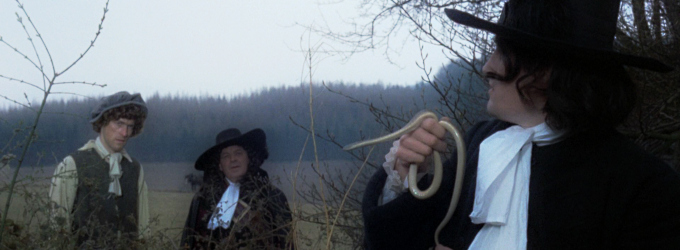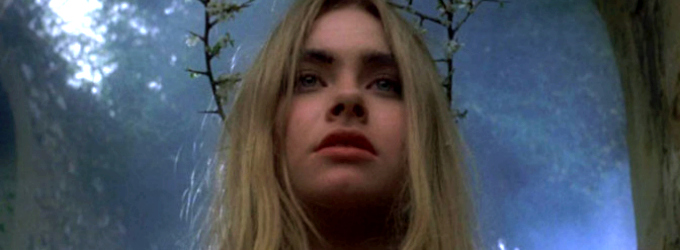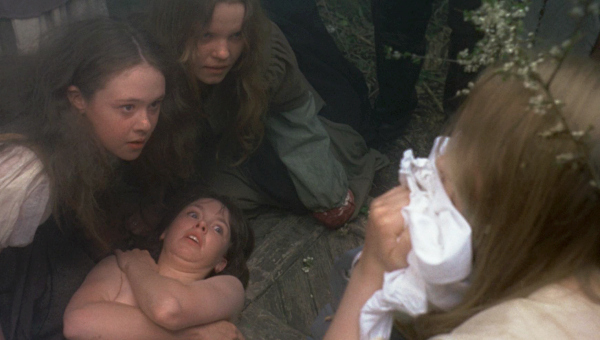 British Horror of the late 60s and early 70s is often marked out for the slow, painful death of possibly the most British of all production studios – Hammer Film Productions. Stale ideas and tired sequels eventually brought the Bray studios to its knees. But as the once proud bones of Hammer were lowered into the crypt, some of the most subversive and experimental horror cinema Britain has ever seen was being made by the new off-shoots left behind. Folk Horror, a brief and vibrant sub-genre taken up by the likes of Amicus, British Lion Films and Tigon Productions, sprouted during this twilight period. Plundering Hammer’s love of the English countryside, these pictures revelled in the rituals, cults and history of rural practice, dissecting society, and often inverting the pleasures and conservatisms of the Home Counties into some of our greatest fears. THE WITCHFINDER GENERAL and THE WICKER MAN are the two pillars of Folk Horror, but there is a third, BLOOD ON SATAN’S CLAW, deserving of the same mantle.
British Horror of the late 60s and early 70s is often marked out for the slow, painful death of possibly the most British of all production studios – Hammer Film Productions. Stale ideas and tired sequels eventually brought the Bray studios to its knees. But as the once proud bones of Hammer were lowered into the crypt, some of the most subversive and experimental horror cinema Britain has ever seen was being made by the new off-shoots left behind. Folk Horror, a brief and vibrant sub-genre taken up by the likes of Amicus, British Lion Films and Tigon Productions, sprouted during this twilight period. Plundering Hammer’s love of the English countryside, these pictures revelled in the rituals, cults and history of rural practice, dissecting society, and often inverting the pleasures and conservatisms of the Home Counties into some of our greatest fears. THE WITCHFINDER GENERAL and THE WICKER MAN are the two pillars of Folk Horror, but there is a third, BLOOD ON SATAN’S CLAW, deserving of the same mantle.
Following the success of THE WITCHFINDER GENERAL, Tigon British Film Productions looked for another box office success. BLOOD ON SATAN’S CLAW, a script written by Robert Wynne-Simmons, was given Piers Haggard, an as-yet unblooded director. Drawing from earlier success, the drama revolved around the dirt and dour of 17th C witchcraft. Unearthing an eye in the fields, an unnamed village becomes stalked by a malevolent spirit. First taking hold of the betrothed of the local gentry, the pestilence then moves to the young of the county, and in particular, the ironically named Angel Blake, who becomes ringleader of the juvenile cult. As events unfold it becomes clear that it is the devil himself who is goading on the youths, with ritualistic rape and scalping his means to becoming incarnate on earth. Following some hap-hazard attempts by the villagers, it is the local judge who takes the task of banishing the beast upon himself.
‘you are a town man, you do not know the dark ways of the country.’
One of the evident facets of BLOOD ON SATAN’S CLAW is the film’s root in the cinema and events of its period. Like the Hammer classics before it, it shared a taste for gore and nudity. But it is in Hammer’s love of the English countryside, however, that Haggard’s picture really adjoins. It is the very earth and turf of the fields themselves that appear to be the residence of the devil. Having been dug up by the plough, the devil and his cult live in the woods, crowning themselves with wreaths of flowers. As the local physician replies to the cynical judge of the village, ‘you are a town man, you do not know the dark ways of the country.’ Rather than Blake’s “dark Satanic mills”, it is the rolling hills of Britain themselves which contain true evil.
Yet it is the devil’s manifestation in human society that portrays the wider context of the production – the 60’s, counter culture, and free love. Rather than the “evil individual versus society” found in its predecessor THE WITCHFINDER GENERAL, or the “individual versus evil society” of its successor THE WICKER MAN, BLOOD ON SATAN’S CLAW has society fall in upon itself. There are no human outsiders entering the village in Haggard’s film; conflict is completely from within. The fault-lines of this division lie in age. It is the young that form the devilish cult, whilst the old defend the vestiges of the church, law and social propriety. This is most clearly embodied in Angel and the stern local curate, Fallowfield, and their clashes. Draped in white robes and a floral wreath, the young cult leader would struggle to look more like a late-60’s-Jefferson-Airplane hippie with a guitar and pair of John Lennon sunglasses. Her weapon against the churchman is sexual temptation, a perverted free love of the cult of youth. In contrast, the curate is forever in black clothes and a blacker frown. The austere Fallowfield resists Angel’s allure but there are plenty in the community who are unable, and the ritual rape mid-film is marked out by the large number of entranced on-lookers packed into the ruins of the old-church. Counter-culture is brought to early modern England in Haggard’s drama, with a bit of devilry added in for good measure.

It is not so clear, however, that good old fashioned English civility and restraint are the hero of the drama. In fact, there is plenty of subversive modernity winding like ivy throughout the film. Once again it comes from the divided society. The conflict of youth and age, sexual norms and diversity, is not the product of the devil, but is evident from the film’s first moments. The young gentleman’s son, upon bringing his low-born fiancée to see his aunt and uncle, is treated with sarcasm and scorn. Moments later the judge treats young Ralph’s discovery of witchcraft with equal cynicism and derision. The youth are scorned by the old as a social fact. Satan accentuates these conflicts but is not their source. The pupils of the pastor are bored and tired of his lessons before joining the cult, and refuse to attend afterwards. Although hyper-sexual, the young devil-worshippers do not appear bewitched by Angel or her master, but appear to be acting out of free will – pleasure and reward of the Devil’s “games” appears to be their only motive, and motive enough.
Rather than conservative, there is something piercing and radical in Haggard’s picture.
Nor do the rules and authority of the adults of the village appear particularly attractive. In fact there is a lot of similarity between the two opposing sides. As the film and cult develop, the narrative increasingly takes the view-point of the young farm-hand Ralph, the camera moving from its low, earth-bound shots, to short cuts from his perspective. Like Ralph we are initially disgusted by the cult’s practices. Yet equal disgust is shown towards the mob-justice and witch-trials of the villagers, who also resort to scalping, a practice of the cult, in an attempt to lift the devil’s curse. By the end of the film, it is the Judges’ claim to remove the devilry “at all cost” which as much if not more of a concern to the audience as the practices of Angel and her followers. Ralph certainly appears more concerned with the Judge’s actions, and by the films last moments Ralph appears to have joined the cult and their rituals.
Rather than conservative, there is something piercing and radical in Haggard’s picture. In many ways, it is a precursor to the sexual subversiveness of THE WICKER MAN. An alternative social structure of liberty and pleasure is set up in contrast to the church and state, with the audience left split over whom to support. BLOOD ON SATAN’S CLAW is not as sophisticated or as richly constructed as Robert Hardy’s 1973 film, but there is something particularly British about the issues in contention. In both, traditional British values are on trial. But what is particular to BLOOD ON SATAN’S CLAW is that the accuser is from within, from the young. It is youth in revolt with a satanic edge. Although based in the conflicts of the late 60s, there is something almost perennial, almost indicative in this conflict of young versus old. It is omnipresent in modern British culture. The struggle over how one should act, tradition or innovation is in itself British, and can be seen repeated throughout British cinema from BLOOD ON SATAN’S CLAW onwards.
httpvh://youtu.be/opI-gVTHPH4

